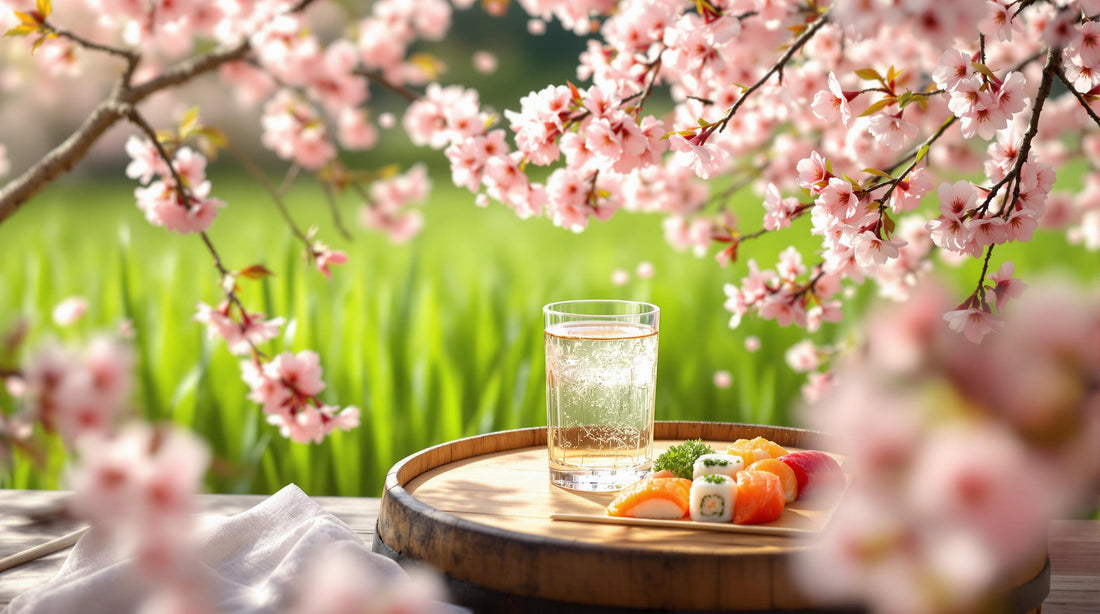
Top Spring Sake Regions in Japan
Share
Spring in Japan brings Haruzake, a seasonal sake crafted to celebrate the arrival of cherry blossoms. Each region adds its own character, influenced by local water, rice, and brewing traditions. Here’s a snapshot of the top regions and their standout spring sake styles:
- Hyogo Prefecture: Known for bold, full-bodied sake made with Yamada Nishiki rice and mineral-rich miyamizu water.
- Kyoto Prefecture: Offers delicate, aromatic sake from the Fushimi district, using soft Gokosui water.
- Yamagata Prefecture: Famous for crisp, clean Ginjo and Daiginjo sake, thanks to its soft water and precise brewing.
- Toyama Prefecture: Features smooth, dry sake with a touch of sweetness, crafted with local snowmelt water and rice.
- Tohoku Region: Produces crisp, balanced sake with complex flavors, ideal for pairing with local dishes.
Quick Comparison
| Region | Key Feature | Famous Pairing |
|---|---|---|
| Hyogo | Bold, full-bodied flavors | Akashiyaki |
| Kyoto | Delicate, aromatic profile | Kaiseki cuisine |
| Yamagata | Clean, polished finish | Red meat dishes |
| Toyama | Smooth, slightly sweet | Fresh seafood |
| Tohoku | Crisp, complex flavors | Kiritanpo, ramen |
Spring sake is best enjoyed chilled, paired with seasonal foods, and often features sakura-themed designs. Whether you're sipping under cherry blossoms or exploring regional varieties, Haruzake captures the essence of Japan’s spring season.
Birthplace of Sake: Exploring Itami & Nada Regions
1. Hyogo Prefecture
Hyogo Prefecture leads Japan in sake production, accounting for 30% of the nation's output [1]. Its spring sake stands out, thanks to natural elements that create ideal brewing conditions.
The region's miyamizu water, sourced from the mineral-rich Rokko Mountains, and the Nada district's cold winters provide the foundation for brewing robust sake [1]. This water, with its unique mineral composition, plays a key role in producing the bold, full-bodied sake that the area is known for.
Hyogo is also home to Yamada Nishiki rice, often called the "king of sake rice." This rice dissolves easily during brewing, resulting in sake with layers of depth and complexity [1][2]. The local climate further enhances the rice's quality, making it an excellent choice for crafting premium spring sake.
Renowned breweries such as Hakutsuru and Honda Shoten blend time-honored techniques with modern advancements, highlighting Hyogo's expertise in sake-making. In the Nada district, the Tamba toji master brewers continue to preserve and refine the region's sake traditions, particularly when producing spring varieties [2].
Hyogo’s spring sake is known for its rich and full-bodied profile, crafted with top-tier ingredients like Yamada Nishiki rice and miyamizu water. This balance of quality ingredients and skilled brewing results in sake that reflects the region's strong brewing heritage. It pairs beautifully with seasonal dishes, especially Akashiyaki, a local specialty with a savory, umami flavor that complements the sake's robust character [1].
Next, we’ll explore Kyoto, where spring sake takes on a more refined and elegant approach.
2. Kyoto Prefecture
Kyoto's Fushimi district is famous for its refined spring sake, thanks to the area's underground Gokosui water system. This low-mineral water creates sake with a delicate and aromatic profile, making it a standout in the world of Japanese brewing [1].
Since 1842, breweries like Takara Group have been drawn to Fushimi's unique water and brewing environment. Today, the district is home to renowned names such as Gekkeikan and Kizakura. These breweries masterfully combine tradition with modern techniques, crafting exceptional sake such as nama sake and incorporating local ingredients like Yamada Nishiki rice and Yuzu citrus [1][4].
The elegance of Kyoto's spring sake comes from the perfect harmony of Gokosui water and innovative brewing methods. Breweries like Kitagawa Honke and Mukai Sake Brewery offer visitors the chance to explore this craftsmanship through tours and tastings, providing a firsthand look at their unique brewing processes [3].
Sake production is a vital part of Kyoto's economy, and visitors can immerse themselves in the region's sake culture. Pairing spring sake with traditional kaiseki cuisine highlights its delicate flavors, creating a memorable culinary experience [1][3].
While Kyoto is known for its graceful and subtle spring sake, the vibrant and bold varieties from Yamagata Prefecture provide an intriguing contrast.
3. Yamagata Prefecture
Yamagata Prefecture has carved out a name for itself in Japan's sake world, especially for its focus on premium Ginjo and Daiginjo varieties. The region's soft water, with its low mineral content, plays a key role in creating sake with a crisp body, gentle acidity, and a clean, polished finish [1].
One of the highlights of Yamagata's sake is how well it pairs with a wide range of foods. Its clean and balanced profile makes it a great match not only for traditional Japanese dishes but also for richer options like red meat and ramen [1].
Breweries in Yamagata have earned a reputation for their skill in crafting Ginjo and Daiginjo sake, reflecting an exceptional level of precision in their brewing methods. This commitment has solidified Yamagata's position as a leader in Japan's high-end sake production [1].
For those visiting Yamagata, exploring the local breweries offers a chance to dive into the region's sake culture. Brewery tours and tastings provide an opportunity to savor the nuanced flavors that define Yamagata's spring sake [1].
Next, we turn to Toyama Prefecture, where distinct brewing traditions bring a fresh perspective to spring sake.
sbb-itb-d9fb1bc
4. Toyama Prefecture
Toyama Prefecture's sake owes its character to the region's pure water sources, including snowmelt from the Tateyama Mountains and Toyama Bay. This water gives the sake its clean, dry taste with a touch of sweetness. The smooth texture pairs perfectly with the area's seafood, especially the fresh catch from Toyama Bay.
Two breweries stand out in Toyama's sake scene: Masuda Tokubetsu Junmai and Tateyama Brewery. They specialize in premium junmai sake, crafted with local rice varieties like Gohyakumangoku and Kitanishiki. These ingredients, combined with the region's water and climate, create a sake profile unique to Toyama.
The prefecture's steady climate plays a key role in its sake production. Cool, humid conditions provide an ideal environment for brewing, ensuring consistent quality throughout the season.
The Toyama Sake Festival is a highlight of the year, where visitors can taste a range of sake styles and meet the master brewers behind them. It’s a celebration of the traditions and skills that make Toyama a notable name in Japan's sake culture.
Although Toyama contributes about 3% of Japan's total sake output [1], the focus here is on quality over quantity. While Toyama is known for its smooth and crisp sake, the Tohoku region offers a contrasting variety of bold and creative spring sake styles.
5. Tohoku Region
Tohoku's chilly climate and unique geography make it perfect for brewing sake with crisp, clean profiles and subtle flavors. The cold temperatures allow for a slow fermentation process, which helps develop the complex flavors that define the sake from this region.
Akita Prefecture plays a major role in sake production, contributing 10% of Japan's total output. Known for its Akita Toji brewers, the area produces high-quality sake like Kariho. These skilled brewers use time-honored techniques that give Tohoku sake its distinct character [1].
The region benefits from pristine water sources, such as the Akita Komachi and Kitakami River systems, which add unique mineral qualities to the sake. When combined with locally grown rice varieties, this creates brews that pair perfectly with local dishes like kiritanpo and iburigakko [1].
A standout example of Tohoku's craftsmanship is Dewazakura Shuzo's 'Oka' sake. This brew highlights the region's dedication to blending quality ingredients with traditional brewing methods, while still pushing boundaries [2].
Visitors can enjoy Tohoku's sake culture through seasonal festivals and brewery tours, where they can sample various styles and meet the master brewers behind the craft. These experiences showcase the region's dedication to preserving its brewing heritage while continuing to refine its techniques.
Tohoku's breweries strike a balance between honoring tradition and focusing on small-batch, premium production. This approach reinforces the region's place as a leader in Japan's sake industry, offering a diverse range of flavors that reflect its deep-rooted traditions and innovative spirit.
Enjoying Spring Sake Varieties
Spring sake is best enjoyed when you pay attention to serving temperature and pair it with regional dishes. Here's a quick guide to help you match sake with its ideal conditions and local specialties:
| Region | Ideal Temperature | Signature Pairing |
|---|---|---|
| Hyogo | 10-15°C (50-59°F) | Akashiyaki |
| Kyoto | 5-10°C (41-50°F) | Kaiseki cuisine |
| Yamagata | 5-8°C (41-46°F) | Red meat dishes |
Adjusting the serving temperature can reveal different flavor profiles in spring sake, making each sip a new experience. These seasonal brews naturally complement local dishes, blending centuries of culinary and brewing tradition [2][1].
For those looking to explore, The Sake Company offers discovery boxes featuring premium spring sake. These curated sets allow you to sample regional varieties while learning about the unique brewing styles and serving techniques [1].
Spring sake is also a favorite for seasonal gatherings like Hanami. Its light and refreshing qualities pair beautifully with outdoor celebrations and seasonal foods. Whether you're enjoying it under cherry blossoms or alongside a springtime meal, it’s a wonderful way to welcome the season [1].
Sampling these spring sake varieties is a delightful way to connect with Japan's rich brewing heritage while celebrating the arrival of warmer days.
Conclusion
Japan's spring sake regions showcase centuries of brewing traditions influenced by local water, rice, and techniques. From Hyogo's bold, full-bodied sakes to Kyoto's delicate, aromatic brews and Yamagata's crisp, clean flavors, each region offers a distinct experience tied to Japan's sake-making heritage [1][2].
The unique qualities of each area's water and brewing methods create a rich variety of flavors, highlighting the diversity of Japanese sake [1][4]. For those looking to explore these flavors, curated selections make it easier to experience the best each region has to offer.
"The diversity of Japan's spring sake regions enriches its cultural heritage, offering enthusiasts a wide range of flavors and brewing techniques." [1]
The Sake Company provides curated discovery boxes, such as the Tsuchida and Hiraizumi boxes, which feature regional sake varieties.
Breweries like Hakutsuru and Kizakura combine tradition with modern approaches, keeping spring sake appealing to today's tastes [2][4]. This blend of old and new ensures that Japan's sake culture remains vibrant and dynamic.
Exploring Japan's spring sake regions reveals more than just varied brewing styles - it highlights the deep connection between local resources and centuries of craftsmanship. Whether through brewery visits or curated selections, each sake reflects the story of its origin. Spring sake celebrates Japan’s respect for nature and tradition, making it an ideal way to honor the season's renewal.
FAQs
These FAQs dive deeper into Japan's sake culture, adding context to the regional highlights mentioned earlier.
Which prefecture produces the most sake?
Hyogo Prefecture leads Japan in sake production, accounting for 30% of the nation’s output. This success stems from its miyamizu water and Yamada Nishiki rice, which together create bold, rich flavors [1]. The region’s spring sake, known for its depth, is especially popular during the season [2].
"The quality of sake in Hyogo Prefecture is attributed to the region's mineral-rich hard water, known as miyamizu, and the use of Yamada Nishiki rice, which is highly absorbent and dissolves easily, resulting in a rich, full-bodied flavor" [1]
Which Japanese city is famous for sake?
Kobe City's Nada district stands out as Japan's most famous sake-producing area. It benefits from miyamizu water, cold winters, and the use of Yamada Nishiki rice [2]. This district is home to renowned breweries like Hakutsuru Sake Brewery, which blend traditional methods with modern innovations. The result? Exceptional sake that upholds the area's long-standing brewing reputation [2].
